The Mobile Laser Scanning Market is estimated to be valued at USD 31.7 billion in 2025 and is projected to reach USD 134.1 billion by 2035, registering a compound annual growth rate (CAGR) of 15.5% over the forecast period.
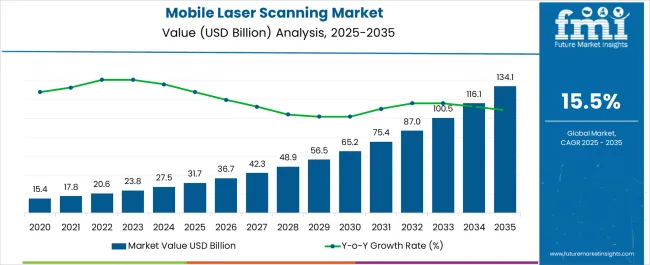
| Metric | Value |
|---|---|
| Mobile Laser Scanning Market Estimated Value in (2025 E) | USD 31.7 billion |
| Mobile Laser Scanning Market Forecast Value in (2035 F) | USD 134.1 billion |
| Forecast CAGR (2025 to 2035) | 15.5% |
The mobile laser scanning market is experiencing strong growth as industries increasingly prioritize high precision mapping, infrastructure monitoring, and digital twin development. The technology is valued for its ability to deliver rapid, accurate, and georeferenced 3D data in diverse environments ranging from urban landscapes to industrial facilities.
Advancements in sensor accuracy, software integration, and data processing speeds are accelerating adoption across multiple sectors. Growing investments in smart city projects, transportation infrastructure, and automated surveying solutions are further driving market momentum.
Regulatory support for advanced geospatial technologies and the push for digitization in construction and asset management are reinforcing adoption trends. The outlook remains positive as mobile laser scanning systems are increasingly viewed as essential tools for reducing project timelines, minimizing errors, and enhancing cost efficiency.
The market is segmented by Solution and Applications and region. By Solution, the market is divided into Mobile Laser Scanning System, Inertial Measurement Systems, Mobile Mapping Platforms, GPS/Positioning Systems, and Mobile Laser Scanning Services. In terms of Applications, the market is classified into Architecture, Civil Engineering, Mining Survey, Forestry Agricultural Survey, and Others. Regionally, the market is classified into North America, Latin America, Western Europe, Eastern Europe, Balkan & Baltic Countries, Russia & Belarus, Central Asia, East Asia, South Asia & Pacific, and the Middle East & Africa.
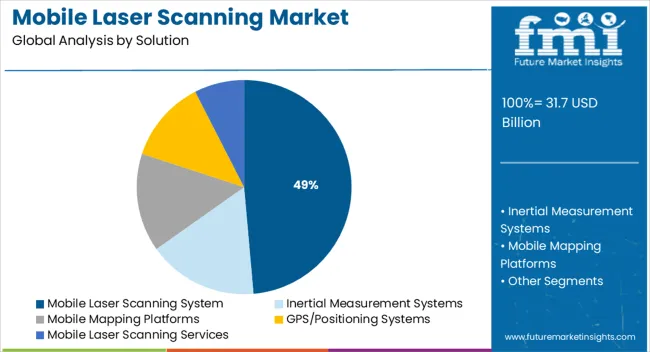
The mobile laser scanning system solution segment is projected to hold 48.60% of total revenue by 2025 within the solution category, making it the leading segment. This dominance is attributed to the system’s capability to capture highly detailed spatial data in real time while operating across complex terrains and large scale projects.
The demand for comprehensive, end to end solutions that combine hardware, software, and analytics has further strengthened the preference for complete systems. Their integration with GNSS and IMU technologies has enhanced positional accuracy, while compatibility with BIM and GIS platforms has expanded usability across industries.
These advantages have positioned mobile laser scanning systems as the most relied upon solution in the market.
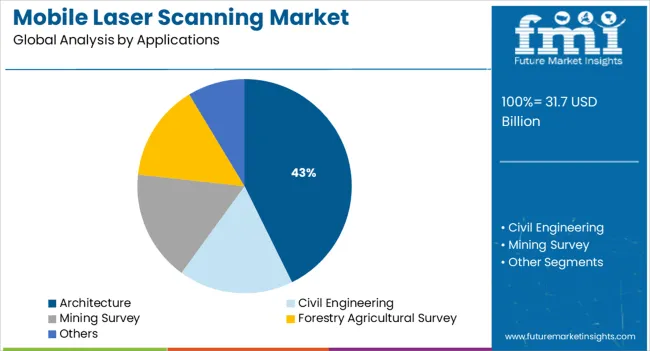
The architecture application segment is expected to account for 42.70% of total revenue by 2025 under the application category, ranking it as the most significant end use. Growth in this segment is being driven by the rising need for accurate structural documentation, renovation planning, and heritage preservation.
The ability of mobile laser scanning to generate precise 3D models has improved project visualization, collaboration, and design validation. Adoption has also been reinforced by the technology’s ability to reduce survey time, minimize human error, and support cost effective planning.
As architects and construction professionals increasingly integrate digital workflows and BIM platforms, the reliance on mobile laser scanning for architectural applications continues to strengthen, securing its leading market share.
In emergency response situations, MLS systems are used to analyze ground conditions quickly for mapping projects like Google Maps and Street View. The survey of areas, which are not safe or accessible for teams, is done by mobile laser scanning technology.
MLS systems immediate information, improves accuracy and quality and also help in cutting the cost. Such factors will drive the market of mobile laser scanning in upcoming years.
Mobile laser scanning streamlines coordination on a site of project, which leads to a better decision making. The MLS systems capture every details or data, which can be used for renovations, demolitions, building additions and building operations. This is one of the factor, fueling the demand of mobile laser scanning globally.
Construction industry is adopting MLS systems for collecting accurate measurements mm to cm apart. The MLS technology has advantages of capturing comprehensive feature informations and fast-tracking a project, which makes these systems suitable for mining survey, architecture and civil engineering.
There are different types of land surveyors investing in new technologies such as mobile laser scanning around the world. Such trends are helping the MLS market to grow during the forecast period.
In the developed economies, there is an increase in demand for reliable and efficient mobile laser scanning. Due to high purchasing power, the trend is highly evident in developed economies across the globe.
Mobile laser scanning equipment are also used for surveying applications in the natural sciences field, where the requirements include mobility and precision in variable terrain conditions. Such trends are continuously contributing to the growth of MLS market.
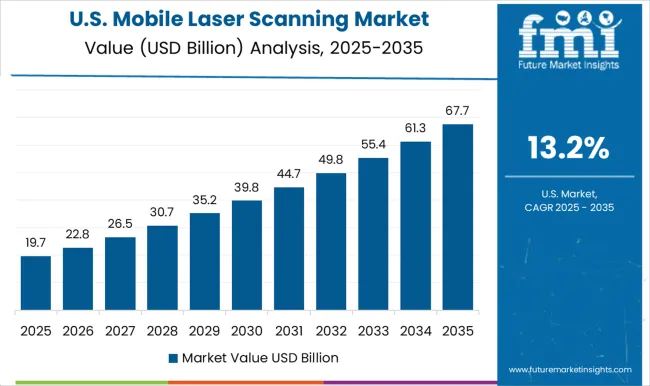
North America has majority of the key vendors of MLS solutions. This is one of the major factor driving the market growth. All the major companies in construction industry are moving towards the adoption of MLS solutions for 3D laser scanning.
The growing demand for surveys in the region through MLS solutions has opened new growth avenues for its market. Most of the states in Canada and United States are making strides and tops in the implementation of mobile laser scanning technology.
Middle East Africa is expected to witness a high growth as the region is witnessing high demand of Mobile Laser Scannings. There is an increase in use of laser scanning technologies by prominent surveying companies for surveying of lands, which will further fuel the growth of MES market in the region.
Various countries in Middle East is focusing on the digitalization of their assets through developing new infrastructures and 3-dimensional scanning techniques. Due to such factors, the market of MLS solution will see many opportunities for growth in this region in upcoming years.
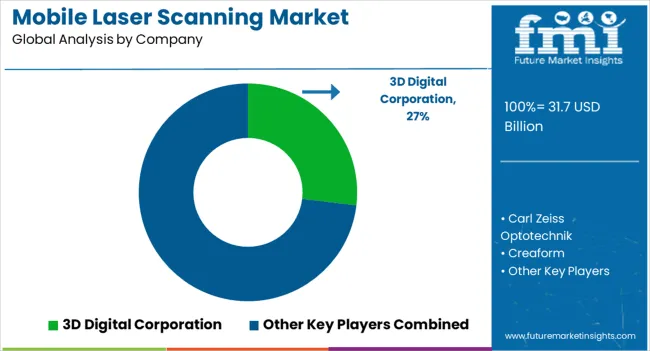
Some of the leading vendors of mobile laser scanning include
These players are focusing on expanding and deploying new lineup of mobile laser scanning solutions to meet rising demands from various end-user industries.
The report is a compilation of first-hand information, qualitative and quantitative assessment by industry analysts, inputs from industry experts and industry participants across the value chain.
The report provides in-depth analysis of parent market trends, macro-economic indicators and governing factors along with market attractiveness as per segments. The report also maps the qualitative impact of various market factors on market segments and geographies.
The global mobile laser scanning market is estimated to be valued at USD 31.7 billion in 2025.
The market size for the mobile laser scanning market is projected to reach USD 134.1 billion by 2035.
The mobile laser scanning market is expected to grow at a 15.5% CAGR between 2025 and 2035.
The key product types in mobile laser scanning market are mobile laser scanning system, inertial measurement systems, mobile mapping platforms, gps/positioning systems and mobile laser scanning services.
In terms of applications, architecture segment to command 42.7% share in the mobile laser scanning market in 2025.






Full Research Suite comprises of:
Market outlook & trends analysis
Interviews & case studies
Strategic recommendations
Vendor profiles & capabilities analysis
5-year forecasts
8 regions and 60+ country-level data splits
Market segment data splits
12 months of continuous data updates
DELIVERED AS:
PDF EXCEL ONLINE
Mobile Application Store Market Size and Share Forecast Outlook 2025 to 2035
Mobile Money Market Forecast and Outlook 2025 to 2035
Mobile Application Testing Solution Market Size and Share Forecast Outlook 2025 to 2035
Mobile Cardiac Telemetry System Market Size and Share Forecast Outlook 2025 to 2035
Mobile Robots Market Size and Share Forecast Outlook 2025 to 2035
Mobile Crane Market Size and Share Forecast Outlook 2025 to 2035
Mobile Vascular Imaging Market Size and Share Forecast Outlook 2025 to 2035
Mobile Animal Inhalation Anesthesia Machine Market Size and Share Forecast Outlook 2025 to 2035
Mobile Unified Communications and Collaboration (UC&C) Solution Market Size and Share Forecast Outlook 2025 to 2035
Mobile Data Protection Market Size and Share Forecast Outlook 2025 to 2035
Mobile Medical Tablets Market Size and Share Forecast Outlook 2025 to 2035
Mobile WLAN Access Points Market Size and Share Forecast Outlook 2025 to 2035
Mobile Social Networks Market Size and Share Forecast Outlook 2025 to 2035
Mobile Printer Market Size and Share Forecast Outlook 2025 to 2035
Mobile Application Development Platform Market Size and Share Forecast Outlook 2025 to 2035
Mobile Threat Management Security Software Market Size and Share Forecast Outlook 2025 to 2035
Mobile Broadband Infrastructure Market Size and Share Forecast Outlook 2025 to 2035
Mobile Enterprise Application Development Platform Market Size and Share Forecast Outlook 2025 to 2035
Mobile Analytics Market Size and Share Forecast Outlook 2025 to 2035
Mobile Robotics Software Market Size and Share Forecast Outlook 2025 to 2035

Thank you!
You will receive an email from our Business Development Manager. Please be sure to check your SPAM/JUNK folder too.
Chat With
MaRIA